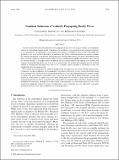Nonlinear Saturation of Vertically Propagating Rossby Waves
Author(s)
Giannitsis, Constantine; Lindzen, Richard Siegmund
DownloadGiannitsis-2009-Nonlinear Saturation.pdf (2.042Mb)
PUBLISHER_POLICY
Publisher Policy
Article is made available in accordance with the publisher's policy and may be subject to US copyright law. Please refer to the publisher's site for terms of use.
Terms of use
Metadata
Show full item recordAbstract
The interaction between vertical Rossby wave propagation and wave breaking is studied in the idealized context of a beta-plane channel model. Considering the problem of propagation through a uniform zonal flow in an exponentially stratified fluid, where linear theory predicts exponential wave growth with height, the question is how wave growth is limited in the nonlinear flow. Using a numerical model, the authors examine the behavior of the flow as the bottom forcing increases through values bound to lead to a breakdown of the linear solution within the computational domain. Focusing on the equilibrium flow obtained for each value of the bottom forcing, an attempt is made to identify the mechanisms involved in limiting wave growth and examine in particular the importance of wave–wave interactions. The authors also examine the case in which forcing is continuously increasing with time so as to enhance effects peculiar to transiency; it does not significantly alter the main results.
Wave–mean flow interactions are found to dominate the dynamics even for strong bottom forcing values. Ultimately, it is the modification of the mean flow that is found to limit the vertical penetration of the forced wave, through either increased wave absorption or downward reflection. Linear propagation theory is found to capture the wave structure surprisingly well, even when the total flow is highly deformed. Overall, the numerical results seem to suggest that wave–wave interactions do not have a strong direct effect on the propagating disturbance. Wave–mean flow interactions limit wave growth sufficiently that a strong additional nonlinear enstrophy sink, through downscale cascade, is not necessary. Quantitatively, however, wave–wave interactions, primarily among the lowest wavenumbers, prove important so as to sufficiently accurately determine the basic state and its influence on wave propagation.
Date issued
2009-04Department
Massachusetts Institute of Technology. Department of Earth, Atmospheric, and Planetary SciencesJournal
Journal of the Atmospheric Sciences
Publisher
American Meteorological Society
Citation
Giannitsis, Constantine, and Richard S Lindzen. “Nonlinear Saturation of Vertically Propagating Rossby Waves.” Journal of the Atmospheric Sciences (2009): 915-934. © 2009 American Meteorological Society
Version: Final published version
ISSN
0022-4928